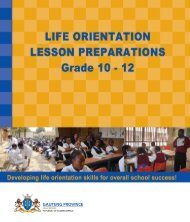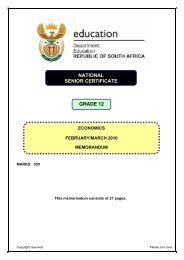Life Science Grade 11
Life Science Grade 11
Life Science Grade 11
Create successful ePaper yourself
Turn your PDF publications into a flip-book with our unique Google optimized e-Paper software.
<strong>Grade</strong> <strong>11</strong> <strong>Life</strong> <strong>Science</strong>s Lesson Plans• Flowers tend to be large red or orange tubes with a lot of dilute nectar• Flowers are not scented• Learners should draw the general structure of a flower from anangiosperm (emphasis must be put on reproductive structures in thediagram)3. Conclusion:• Go through the structures that are needed in flowers for reproduction• Emphasize that plants have different adaptations to ensure pollinationby different types of pollinators• Diagram may be completed as homework• Pre-preparation for next lesson’s practical:• You will need to get one specimen of each type of flower for the nextlesson: wind-pollinated – E.g grass, Restios, insect- pollinated flowersE.g Daisy, hibiscus, black-eyed Susan, bird- pollinated E.g aloe,Strelitzia10 min5 minDiagram of structure offlower:• Solutions for all <strong>Life</strong><strong>Science</strong>s Gr. <strong>11</strong> pp. 71;Oxford Successful <strong>Life</strong><strong>Science</strong>s pp. 44Term 1 Page 48© Gauteng Department of Education (CAPS version)







